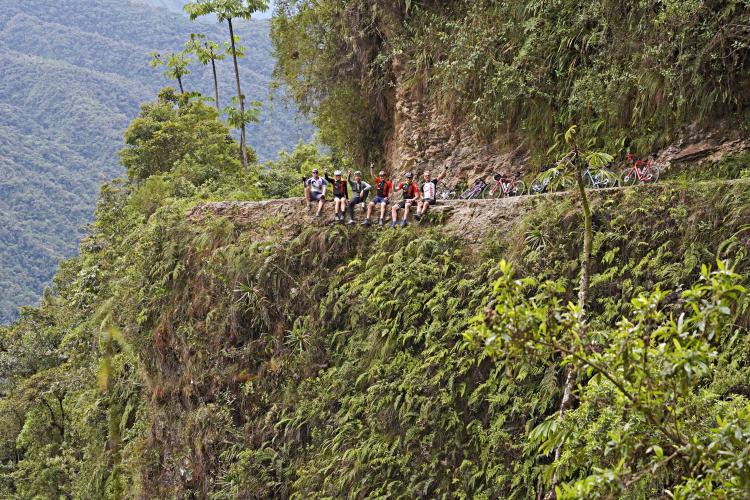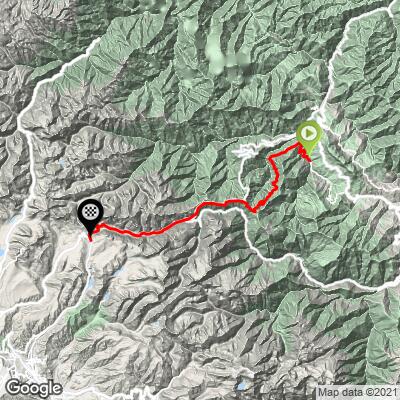
INTRO
PLAN YOUR ROUTE
 We've partnered with Sherpa-Map.com to bring you the best route planning tool. With a PRO Membership you can use this climb as a reference when creating your route.
We've partnered with Sherpa-Map.com to bring you the best route planning tool. With a PRO Membership you can use this climb as a reference when creating your route. ROUTE MAP



 We've partnered with Sherpa-Map.com to bring you the best route planning tool. With a PRO Membership you can use this climb as a reference when creating your route.
We've partnered with Sherpa-Map.com to bring you the best route planning tool. With a PRO Membership you can use this climb as a reference when creating your route. 
Cycling the Death Road, the most epic bike climb in the world.
Climb summary by PJAMM’s John Johnson.
This may very well be the greatest road of all! Words cannot describe it, but thankfully our photos and drone video do some justice to this climb. It is a magnificent and otherworldly experience complete with Indiana Jones and Jurassic Park-like surroundings. North Yungas Road, nicknamed “Death Road,” was carved out of the mountainside in the 1930s by Paraguayan prisoners during the Chaco War with Brazil. The road connects La Paz with the town of Coroico, effectively connecting the Amazon rainforest and those who dwell there, with Bolivia’s capital city (Curiosity).
Before heading to Bolivia for this once in a lifetime cycling adventure, be sure to rely on our list of Things to Bring on a Cycling Trip, and use our interactive checklist to ensure you don't forget anything.
How to Cycle the Death Road:
To climb the death road by bike you must train seriously for the challenge. This is the third hardest climb by bike in the world (Mauna Kea and Scanuppia take the first and second spots) and the first 30 km are on dirt and gravel, but manageable on a road bike with 32mm tires (I used a Specialized Roubaix with 32mm tires). The grade is never tortuously steep (the steepest half km is 10.2%), but its a long one, at 62 kilometers (38.5 miles). Altitude is also a major factor as this is the highest Top 10 World Climb, topping out at 4,629 meters (15,187’). Staying in the La Paz area for a few days (3,650 m) is helpful in order to acclimate.
When to Climb Bolivia's Death Road:
May through October is the best time to do this ride (La Paz Average Weather).
This is just one amazing road!
We stayed in Coroico, located about two and a half to three hours (70 miles) from El Alto International Airport (in La Paz) and about five miles down amazing, though rough, cobbles to the start of the Death Road.
Bumpy and absolutely epic descent on five miles of cobbles to the start.
The Death Road begins at the bottom of North Yungas Road at the end of a narrow road from Coroico, between several roadside food stands which no doubt exist only due to the popularity of the downhill death road tours that end there. PJAMM, being a bit eccentric, started at this spot and rode against the flow of downhill mountain bike traffic for the nineteen mile death road.[1]
Two kilometers to the start.
Village at the start of the climb.
A lot of downhillers (see mountain bikes on top of vans).
No uphillers (other than crazy Americans!) in our three days on the Death Road!
The first thing to remember when ascending (or descending, as one of our group famously did at an uncomfortably brisk pace -- for “brisk” read: dangerous, watch our video to see for yourself), is that you must drive on the left side of the road. This is for the safety of the downhill driver whose steering wheel is on the left side of the car.[2]
Photo left - PJAMM 2017; photo right - PJAMM 2023
Be prepared to forge at least two streams and bring at least 25 Bolivianos (equivalent to 4 USD, but the toll attendants will only accept Bolivian currency).
During rainy season be prepared to forge rivers.
Costs a few Bolivianos to pass.
Be prepared for Postcard Corner at mile 14.2 of the climb. It is not obvious that you are at this exceptional (perhaps the greatest) epic photo spot. We almost missed it . . . twice!
ONE OF THE MOST EPIC SEGMENTS ON ANY BIKE RIDE
The waterfall section at the 12 kilometer/20 mile mark
This is near the location where two buses collided and 120 people perished in the 1980’s.
POST CARD CORNER
Postcard Corner!
PJAMM 2017
PJAMM 2023
Also known as Devil’s Corner and Curva Clásica - at kilometer 22.7 / mile 14.2
The dirt/rock/gravel portion of this climb is the first nineteen miles, at 7% average grade, gaining 6,307 elevation. Just the first half of this climb would rank it in the top 60 world climbs (adding the next 19.4 miles at 5.9% for 5,245 raises this climb to number three overall in the entire world). This climb has the challenge, lore, difficulty, altitude and breathtaking scenery and surroundings to make it potentially the Best Climb in the World.
THE SECOND HALF OF THE RIDE
First half of climb - 31 km (19.2 miles) at 6.3%
Second half of climb - 31 km (19.3 miles) 4.8% (this includes 5.5 km averaging -1%.
Some exceptional rock formations on the way to La Cumbre.
The final grade to La Cumbre.
THE FINISH - LA CUMBRE PEAK
4,470m = 14,665’ elevation.
Scenes at the top - Laguna Estrellani middle top photo.
Roadway Surface and Traffic Conditions
On the first half of the Death Road climb, the roadway is dirt and rock, but completely manageable on a road bike, particularly with wider tires (JJ rode a Specialized Roubaix with 33mm rear and 32mm front tires). On the second half of the climb, the roadway is fully paved, but on a major highway with moderate traffic that generally moves around 40 mph or less, particularly on the uphill portions by truck (sometimes slowing to five mph).
Pick your poison
First half -- no trucks, but sheer cliffs . . .
Second half -- no sheer cliffs but a lot of nutty drivers!
Deadliest Road in the World:
By now you may be wondering how Death Road got its name. “In 1995 the Inter-American Development Bank christened it as the world's most dangerous road,” and in 2006 it was estimated that “200 to 300 travellers were killed yearly along the road” (Yungas Road). The high death toll is due largely to factors such as “fog, landslides, cascades, and cliffs that drop 2,000 feet (610 meters) at every turn,” as well as the narrow structure of the road -- rarely stretching wider than ten feet across (Curiosity). Since Highway 3 was built as a primary and alternate route to the Yungas region of Bolivia from La Paz, the death toll has decreased, but the road remains extremely hazardous. Wikipedia reports that as of May 2010 at least eighteen cyclists have died on the road since 1998. Please cycle with caution.
There are numerous memorials along the Death Road. See slideshow widget for photos.
If you Google “What is the most dangerous road in the world” North Yungas Road (Death Road) is at the top of the list.
That’s a wrap!!
[1] Note: The Death Road is a 19 mile extremely narrow dirt road that ends around 10,000’ altitude, but we continue another 19 miles up Highway 3 to La Cumbre Peak at 15,300’ to complete the number three Most Difficult World Bike Climb.
[2] Generally, in Bolivia we drive on the right side of the road.